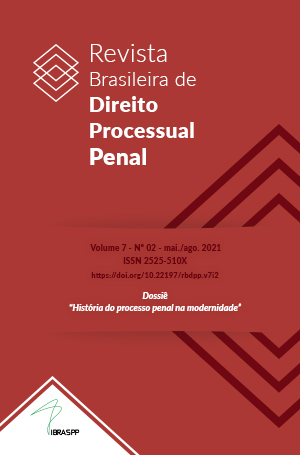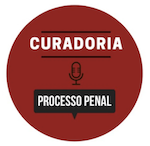La fundamentación de la acusación por medio de las ciencias forenses en el marco del procedimiento penal en Rumanía
DOI:
https://doi.org/10.22197/rbdpp.v7i2.465Palabras clave:
Investigación de la escena del delito, Examen forense, Función de la acusación, Ente de investigación, Fase de investigación, Delitos graves.Resumen
El proceso penal incorpora elementos de las ciencias forenses, que se emplean para realizar los fines del propio procedimiento. La función de la acusación tiene una serie de particularidades, en relación con las cuales la aproximación que se realiza a esta tarea es un factor fundamental a la hora de hacer realidad los principios de justicia en el ámbito penal, desde la perspectiva tanto de las autoridades judiciales como del acusado. Los mecanismos que proporciona el sistema de justicia penal aseguran un equilibrio entre, por un lado, la acusación y la defensa y, por otro, entre la acusación y la resolución. El presente artículo se centra en ciertas características de la función de acusación en el marco de los procedimientos penales, así como en la manera en que se ejerce por medio del recurso a las ciencias forenses. Para alcanzar los objetivos propuestos, se ha empleado una metodología de investigación mixta, basada en un método cualitativo con influencia del estudio de caso y conclusiones obtenido de el análisis de la jurisprudencia en decisiones pronunciadas por los tribunales de justicia en materia penal. En este contexto, las ciencias forenses ofrecen medios y mecanismos jurídicos para que los órganos judiciales logren el objetivo del procedimiento penal, en pleno ejercicio de la función de acusación.
Descargas
Referencias
Activity Report. National Institute of Forensic Examinations. Ministry of Justice of Romania, 2018. Available at: https://www.inec.ro/images/Documente/RapoarteSiStudii/RA2018.pdf. October 20, 2020.
Aitken, Colin; Roberts, Paul; Jackson, Graham. Fundamentals of Probability and Statistical Evidence in Criminal Proceedings. Guidance for Judges, Lawyers, Forensic Scientists and Expert Witnesses. Royal Statistical Society, v. 121, 2010. Available at: http://eprints.nottingham.ac.uk/1859/1/Aitken,_Roberts_&_Jackson,_Fundamentals_of_Probability_and_Statistical_Evidence_(2010).pdf. Accessed on February 25, 2020.
Aslan, Deniz; Edelmann, Robert. Demographic and offence characteristics: a comparison of sex offenders convicted of possessing indecent images of children, committing contact sex offences or both offences. The Journal of Forensic Psychiatry & Psychology, v. 25, n. 2, 2014, https://doi.org/10.1080/14789949.2014.884618
Botian, Elisabeta. Drept procesual penal. Sibiu: BURG Publishing House, 2016
Braga, Anthony A.; Pierce, Glenn L. Reconsidering the ballistic imaging of crime bullets in gun law enforcement operations. Forensic Science Policy & Management: An International Journal, v. 2, n. 3, 2011, https://doi.org/10.1080/19409044.2011.613444
Carpinean, Ion Cristian. Rolul probelor criminalistice in aflarea adevarului. Revista de Criminologie, Criminalistica si Penologie, n. 4, 2019.
Covalciuc, Ion. New investigative techniques: Regulatory provisions and practical possibilities. Revista de Criminologie, Criminalistica si Penologie, n. 4, 2019.
CRIMINAL Decision no. 2801 of 12 September 2012 of the High Court of Cassation and Justice of Romania. Available at: http://www.scj.ro. Accessed on July 16, 2020.
CRIMINAL Decision no. 2137 of 3 April 2006 of the High Court of Cassation and Justice of Romania. Available at: http://www.scj.ro. Accessed on July 16, 2020.
CRIMINAL Decision no. 277/A of 29 October 2018 of the High Court of Cassation and Justice of Romania. Available at: http://www.scj.ro. Accessed on July 16, 2020.
CRIMINAL Decision no. 542 of 30 October 2019 of the High Court of Cassation and Justice of Romania. Available at: http://www.scj.ro. Accessed on July 16, 2020.
CRIMINAL Decision no. 350 of 28 June 2019 of the High Court of Cassation and Justice of Romania. Available at: http://www.scj.ro. Accessed on July 16, 2020.
CRIMINAL Decision no. 385/RC of 31 October 2018 of the High Court of Cassation and Justice of Romania. Available at: http://www.scj.ro. Accessed on July 16, 2020.
CRIMINAL Decision no. 428/RC of 28 November 2018 of the High Court of Cassation and Justice of Romania. Available at: http://www.scj.ro. Accessed on July 16, 2020.
Douglas, John E.; Burgess, Ann W.; Burgess, Allen G.; Ressler, Robert K. Crime Classification Manual: A Standard System for Investigating and Classifying Violent Crime. Third ed. New Jersey: Wiley, 2013.
D'Silva, Karen; Duggan, Conor. Revisiting the overcontrolled-undercontrolled typology of violent offenders. Personality and Mental Health, n. 4, 2010, https://doi.org/10.1002/pmh.130
Dumba, Dumitru. Consideratiuni in legatura cu dispunerea prin ordonanta de catre procurorul care efectueaza urmarirea penala a expertizelor care au ca obiect stabilirea valorii in vama a marfurilor. Dreptul, n. 9, 2010.
Fraser, Jim. The application of forensic science to criminal investigation. In: Newburn, Tim; Williamson, Tom; Wright, Alan (eds.). Handbook of criminal investigation. New York: Willan Publishing, 2007.
Geberth Vernon J. Practical homicide investigation. Tactics, procedures, and forensic techniques. Fifth ed., Boca Raton: Taylor & Francis Group, 2015.
GEHL, Rod; PLECAS, Darryl. Introduction to Criminal Investigation: Processes, Practices and Thinking. New Westminster, BC: Justice Institute of British Columbia. 2016, p. 148. Available at: https://pressbooks.bccampus.ca/criminalinvestigation. Accessed on April 4, 2020.
High Court of Cassation and Justice of Romania. Penal Decision no. 847 of 17 October 2018. Available at: https://www.scj.ro. Accessed on March 6, 2020.
Horswell, John. The Practice of Crime Scene Investigation. London - New York: Taylor&Francis, 2004.
Howes, Loene M. The communication of forensic science in the criminal justice system: A review of theory and proposed directions for research. Science and Justice, v. 55, n. 2, 2015, https://doi.org/10.1016/j.scijus.2014.11.002
ITAI. Good Practice in Forensic Road Collision Investigation. A guide for Practitioners. NPCC: South Cerney, 2019. Available at: https://www.itai.org/download/Good-Practice-in-Forensic-Road-Collision-Investigation-V2A.pdf. Accessed on August 12, 2020.
Jurisprudenta CEDO. European Court of Human Rights of Strasbourg, 2008. Available at: https://jurisprudentacedo.com. Accessed on July14, 2020.
KAIJA, S. Issues in separation of criminal procedural functions. Society. Health. Welfare, v. 40, 2018, pp. 1-10. https://doi.org/10.1051/shsconf/20184001010
Kleinlein, Thomas. The procedural approach of the European Court of Human Rights: Between subsidiarity and dynamic evolution. International and Comparative Law Quarterly, v. 68, n. 1, 2019, https://doi.org/10.1017/S0020589318000416
Kosar, David; Petrov, Jan; Sipulova, Katarina; Smekal, Hubert; Vyhnanek, Ladislav; Janovsky, Jozef. Domestic Judicial Treatment of European Court of Human Rights Case Law. New York: Routledge, Taylor & Francis Group, 2020.
Kruse, Corinna. Legal storytelling in pre-trial investigations: arguing for a wider perspective on forensic evidence. New Genetics and Society. v. 31, n. 3, 2012, https://doi.org/10.1080/14636778.2012.687084
Law no. 135 of 2010 on the new Code of Criminal procedure, published in the Official Journal of Romania no. 486 of 15 July 2010, into force on 1 February 2014.
Macoveciuc, Ioana; Rando, Carolyn J.; Borrion, Herve. Forensic gait analysis and recognition: Standards of evidence admissibility. Journal of Forensic Sciences, v. 64, n. 5, 2019, https://doi.org/10.1111/1556-4029.14036
MAGHERESCU, Delia. Criminalistica. Bucharest: Wolters Kluwer, 2017a.
MAGHERESCU, Delia. New Specific Techniques of Investigation for the Economic Offences. In: MOTATU, Adriana; MILITARU, Ioana Nely, (eds). Diversity and Interdisciplinarity in Business Law. Bucharest: ADJURIS International Academic Publisher, 2017b. Available at: http://www.adjuris.ro/reviste/daib/Diversity%20and%20Interdisciplinarity%20%20%20%20%20%20%20in%20Business%20Law.pdf. Accessed on September 21, 2020.
MASSEY, Simon; RANKIN, Glynn. Exploiting people for profit. Trafficking in human beings. London: Palgrave Macmillan, 2020.
Mjanes, Karin L. Testing the Organized/ Disorganized Model of Sexual Homicide. Thesis, Victoria: Simon Fraser University, 2015. Available at: https://summit.sfu.ca/item/15907. Accessed on September 24, 2020.
Monckton-Smith, Jane; Adams, Tony; Hart, Adam; Webb, Julia. Introducing Forensic and Criminal Investigation, Sage Publications, 2013.
Palcu, Pavel. The Need for Diversification of Forensic Tactical Rules Applicable to Crime Scene Investigation. Journal of Legal Studies, v. 19, n. 33, 2017, https://doi.org/10.1515/jles-2017-0012
Pech, Laurent, The Rule of Law as a Guiding Principle of European Union’s External Action, The Hague: T.M.C. Asser Institute, CLEER, 2012, http://dx.doi.org/10.2139/ssrn.1944865
Preliminary Decision no. 113/2019 of 22 February 2019 of the High Court of Cassation and Justice of Romania. Available at: https://www.scj.ro. Accessed on April 15, 2020.
Raoult, Sacha. How ownership of penal history was lost: An anti synthesis of modern criminal law. Journal of Law and Conflict Resolution, v. 4, n. 2, 2012, https://doi.org/10.5897/JLCR11.010
Robertson, James. Forensic science, an enabler or dis-enabler for criminal investigation? Australian Journal of Forensic Sciences, v. 44, n. 1, 2012, https://doi.org/10.1080/00450618.2011.595736
Roux, Claude; Crispino, Frank; Ribaux, Olivier. From Forensics to Forensic Science. Current Issues in Criminal Justice, v. 24, n. 1, 2012, https://doi.org/10.1080/10345329.2012.12035941
Sangero, Boaz; Halpert, Mordechai. Why a conviction should not be based on a single piece of evidence: A proposal for reform, Jurimetrics, v. 48, n. 1, 2007, p. 43-94. Available at: http://www.jstor.org/stable/25767388. Accessed on February 24, 2020.
Santoro, Paola; La Russa, Raffaele; Besi, Livia; Volonnino, Gianpietro; dell'Aquila, Massimiliano; De Matties, Alessandra; Maiese, Aniello, The forensic approach to plastic bag suffocation: Case report and review of the literature, Medico-Legal Journal, v. 87, n. 4, 2019, https://doi.org/10.1177/0025817219861277
Schroeder, David A.; Elink-Schuurman-Laura, Kristin. The impact of forensic evidence on arrest and prosecution. National Institute of Justice. Boston: University of New Haven, 2017. Available at: https://www.ncjrs.gov/pdffiles1/nij/grants/250721.pdf. Accessed on October 21, 2020.
SKORUPKA, Jerzy. The rule of admissibility of evidence in the criminal process of continental Europe. Revista Brasileira de Direito Processual Penal, v. 7, n. 1, pp. 93-122, 2021. https://doi.org/10.22197/rbdpp.v7i1.526
Stancu, Emilian. Tratat de Criminalistica. Bucharest: Actami Publishing House, 2001.
Stoica, Crenguta A. Cercetari privind expertizele din domeniul multimedia. Pro Lege, n. 2-3, 2019.
Theodoru, Grigore. Tratat de drept procesual penal, Third ed. Bucharest: Hamangiu Publishing House, 2013.
Thompson, Robert M. Firearm Identification in the Forensic Science Laboratory. Arlington, VA: National District Attorneys Association, 2010.
Touzeau, Nadine. Transposition of modus operandi from the real to the virtual using several signatures: Case of ”the drowned of the Garonne” serial crimes in France. Forensic Science and Criminology, v. 3, n. 1, 2018, doi: 10.15761/FSC.1000124
United Nations Office on Drugs and Crime. Crime scene and physical evidence examinations in trafficking in persons investigations, New York, 2009. Available at: https://www.unodc.org/documents/human-trafficking/TIP_module7_Ebook.pdf. Accessed on October13, 2020.
Waltke, Heather; LaPorte, Gerald; Weiss, Danielle; Schwarting, Dawn; Nguyen, Minh; Scott, Frances. Sexual Assault Cases: Exploring the Importance of Non-DNA Forensic Evidence. NIJ Journal, n. 279, 2018. Available at: https://www.ncjrs.gov/pdffiles1/nij/250704.pdf. Accessed on October 4, 2020.
Woodman, Peter A.; Spiranovic, Caroline; Julian, Roberta; Ballantyne, Kaye N.; Kelty, Sally F. The impact of chemical trace evidence on justice outcomes: Exploring the additive value of forensic science disciplines. Forensic Science International, v. 307, 2020, https://doi.org/10.1016/j.forsciint.2019.110121
ZARAFIU, Andrei. Procedura penala. Partea generala. Partea speciala, 2nd ed, Bucharest: C.H. Beck, 2015.
ZARAFIU, Andrei. Implications of the new legislation on the fundamental principles of the criminal trial. Challenges of the Knowledge Society. Bucharest: ”Nicolae Titulescu” University Publishing House, pp. 145-155, 2015. Available at: https://www.proquest.com/openview/69cb9471aa57f00f829a7d6cf5465638/1?pq-origsite=gscholar&cbl=2036059. Accessed on May 13, 2021.
Descargas
Publicado
Número
Sección
Licencia
![]()
A partir de 2022, los artículos publicados en el RDPP tienen una licencia Creative Commons Atribuição 4.0 Internacional. Los artículos publicados hasta 2021 adoptaron la licencia Creative Commons Atribuição-NãoComercial 4.0 Internacional.

















